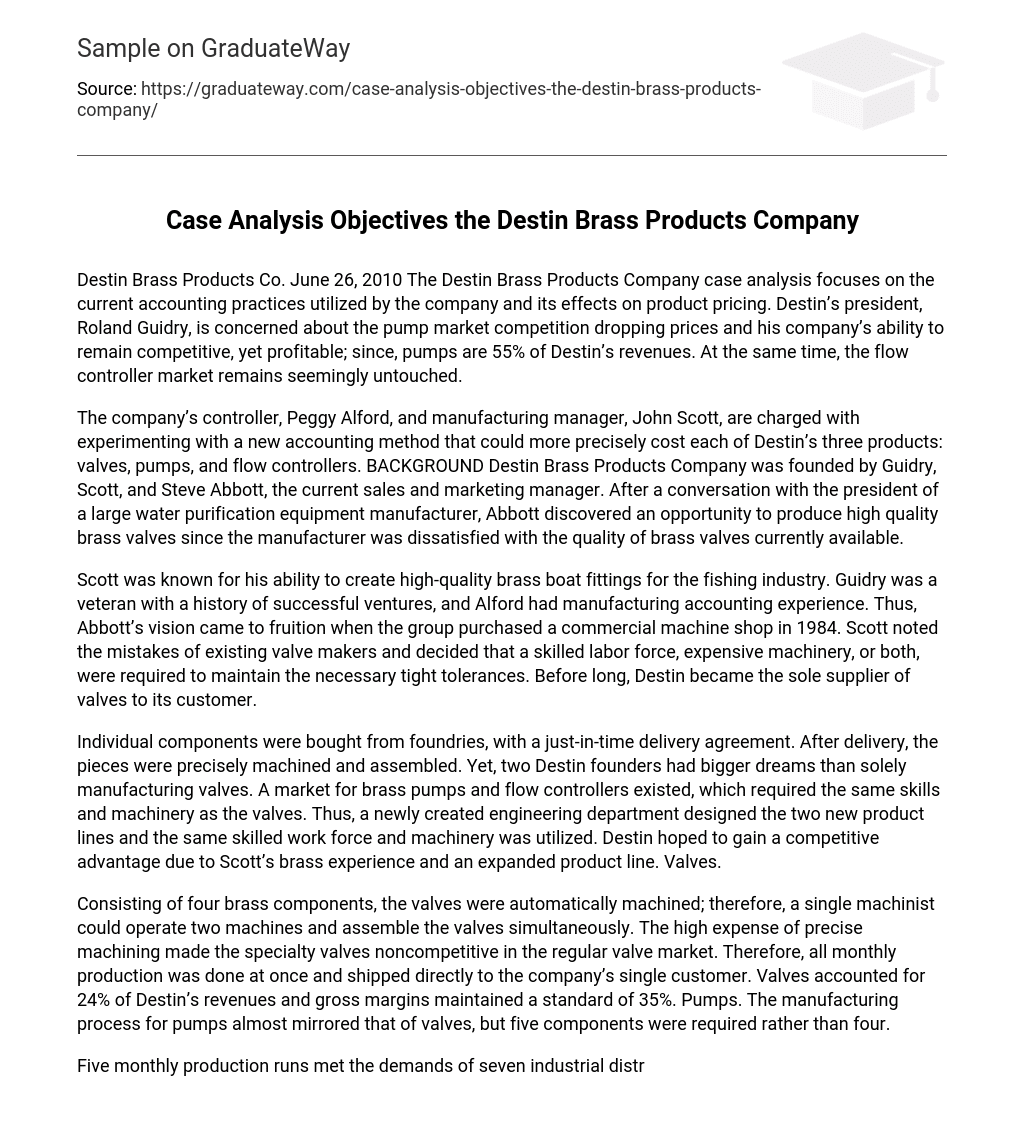The Destin Brass Products Company case analysis focuses on the current accounting practices utilized by the company and its effects on product pricing. Destin’s president, Roland Guidry, is concerned about the pump market competition dropping prices and his company’s ability to remain competitive, yet profitable; since, pumps are 55% of Destin’s revenues. At the same time, the flow controller market remains seemingly untouched.
The company’s controller, Peggy Alford, and manufacturing manager, John Scott, are charged with experimenting with a new accounting method that could more precisely cost each of Destin’s three products: valves, pumps, and flow controllers. Destin Brass Products Company was founded by Guidry, Scott, and Steve Abbott, the current sales and marketing manager. After a conversation with the president of a large water purification equipment manufacturer, Abbott discovered an opportunity to produce high quality brass valves since the manufacturer was dissatisfied with the quality of brass valves currently available.
Scott was known for his ability to create high-quality brass boat fittings for the fishing industry. Guidry was a veteran with a history of successful ventures, and Alford had manufacturing accounting experience. Thus, Abbott’s vision came to fruition when the group purchased a commercial machine shop in 1984. Scott noted the mistakes of existing valve makers and decided that a skilled labor force, expensive machinery, or both, were required to maintain the necessary tight tolerances. Destin became the sole supplier of valves to its customer.
Individual components were bought from foundries, with a just-in-time delivery agreement. After delivery, the pieces were precisely machined and assembled. Yet, two Destin founders had bigger dreams than solely manufacturing valves. A market for brass pumps and flow controllers existed, which required the same skills and machinery as the valves. Thus, a newly created engineering department designed the two new product lines and the same skilled work force and machinery was utilized. Destin hoped to gain a competitive advantage due to Scott’s brass experience and an expanded product line.
Consisting of four brass components, the valves were automatically machined; therefore, a single machinist could operate two machines and assemble the valves simultaneously. The high expense of precise machining made the specialty valves noncompetitive in the regular valve market. Therefore, all monthly production was done at once and shipped directly to the company’s single customer. Valves accounted for 24% of Destin’s revenues and gross margins maintained a standard of 35%. The manufacturing process for pumps almost mirrored that of valves, but five components were required rather than four.
Five monthly production runs met the demands of seven industrial distributors, as long as prices remained competitive. Destin felt the strain of lowering their pump prices in order to remain in the market; thus, resulting in a 22% gross margins in the last month, far below the planned gross margin of 35%, but 55% of their revenues. Flow Controllers require more components, and more labor hours, but the physical manufacturing process is similar to the valves. In recent months, ten production runs resulted in 22 shipments to distributors and other customers.
Unlike the pump market, price competition for the flow controller is mild. Destin Brass was able to raise prices by 12 % with no obvious affect on demand. Flow controllers make up 21% of the company’s revenues. After the latest month’s reports were completed, the group of four met to discuss the results. With higher quality manufacturing capabilities than many competitors, the group could not grasp how the competition could lower prices on pumps and still remain profitable, yet have no price competition in the flow controller arena.
A round table accounting discussion finalized with Guidry directing Scott and Alford to propose a new method of reporting production costs and to answer some key questions.
CASE QUESTIONS
What are the strategic implications of the analysis? What actions would you recommend to the managers at Destin Brass Products? The analysis provides the management of Destin Brass two areas in which to focus their efforts. First, it provides insight into competitor pricing. If management believes ABC is more accurate, the competitor pricing levels makes sense. Pricing on each product line should be reviewed in lieu of the new cost calculations, market pricing, and their desired positioning in the market. Secondly, the cost analysis allows management to take advantage of cost reduction opportunities, especially among the largest controllable items for a product line as opposed to a general cost reduction effort. Recommendations are in the next section.
Assume that interest in a new basis for cost accounting at Destin Brass Products remains high. In the following month, quantities produced and sold, activities, and costs were all standard. How much higher or lower would the net income reported under the activity-transaction-based system be than the net income that will be reported under the present, more traditional system? Why? Although product line profitability will change, if the only change is the use of ABC costing, no change in net income reported under the new cost method will exist. Since ABC reallocates existing costs, no costs are added or eliminated.
RECOMMENDATIONS
In conclusion, with the above questions and answers as substantiation, Alford and Scott should recommend the use of ABC costing going forward. Unit costs for each product line can be more precisely calculated and prices adjusted accordingly to remain competitive and profitable. In addition, cost reductions, where possible, will improve the overall company financial standing. As Alford has mentioned, all necessary tools are already in place to implement the new accounting process with minimal costs.
REFERENCES
- Bruns, W. J. (1997). Destin Brass Products Co. Harvard Business School Publishing.





